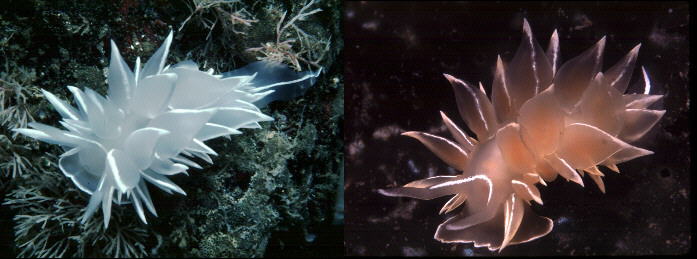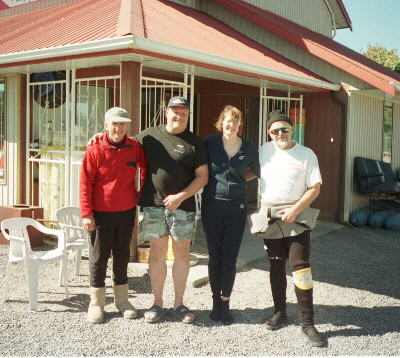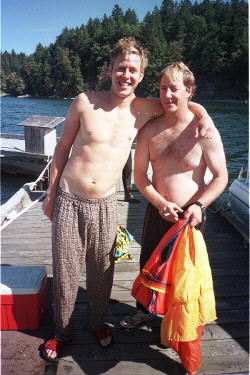 |
Dirona albolineata
Photograph at left taken by Dr. Marc Chamberlain at Port Hardy, British Columbia, CanadaPhotograph at right taken by the Webmaster at Nanaimo, British Columbia, Canada
Dirona albolineata MacFarland in Cockerell & Eliot, 1905
This beautiful white-lined nudibranch reaches up to 17.5 mm in length, and ranges from the cold waters of Alaska to southern California. Its ground color is translucent white, mauve, greenish or peach with opalescent white outlining the broad, flat cerata, oral veil and the midline of the tail. Although it looks like an aeolid nudibranch, it is classified as an arminid because it has a frontal veil, no rhinophore sheathes and the cerata lack branches of the digestive glands and cnidosacs. This means that this species cannot store nematocysts for defence like many aeolid nudibranchs. Indeed, its diet is not cnidarians, but primarily bryozoans although it also eats a large variety of other organisms, even small snails. This generalist diet makes the white lined Dirona relatively easy to maintain in cold water aquaria. How does such a conspicuous animal defend itself? It readily sheds its large flat cerata which, like a lizard's tail, distracts predators. Chemical defences are also likely, but their nature remains unknown.
Dirona albolineata occurs year-round in the shallow subtidal, spawning in both the winter and summer. The irregularly coiled spawn mass has a white folded egg string.
Sandra Millen
Nov., 1999

|
Sandra MillenDepartment of ZoologyUniversity of British Columbia Vancouver, B.C., Canada, V6T 1Z4 Phone (604) 822-2087; Fax (604) 822-2416 Send Sandra E-Mail at millen@zoology.ubc.ca or visit Sandra's home page Sandra is pictured at third from left along with Dave Nesheim (LAUPS), Alan Grant (aka the diving dentist), and Mike Miller (webmaster) taking a break between dives at Nanaimo, British Columbia during a field trip to British Columbia in October of this year. We flew up to Seattle, rented a car and continued up into British Columbia, Canada. We didn't see the number of branchs encountered during our '98 trip report, but nevertheless were able to get spectacular video and still footage of what we did see. The parasitization of Dirona albolineata that we observed on the 98 trip was not evident this year. Dirona albolineata will be the first of a series of BOW's as a result of this trip! And of course, diving Dodd's Narrows is always a must when in the Nanaimo area. We were very happy with our boat skipper Rod and the whole Ocean Explorers Diving operation. |

| Pictured at left are two happy fishermen who had the unfortunate experience to have their fishing skiff capsize off Neck Point. On the other hand, they were fortunate we were diving in the same area and had a skipper (Rod) who also serves as a volunteer in the Canadian Auxiliary Coast Guard. Rod enlisted the aid of Alan and effected the rescue in good speed. Rod was further tested sometime later when Sandra didn't surface going on an hour. We finally located her when she surfaced some hour and twenty minutes later and clamored across the rock spit separating us from the frothing ocean on the other side. All's well that ends well ,but I can tell you we all had some strong liquid refreshment that evening with dinner! |
